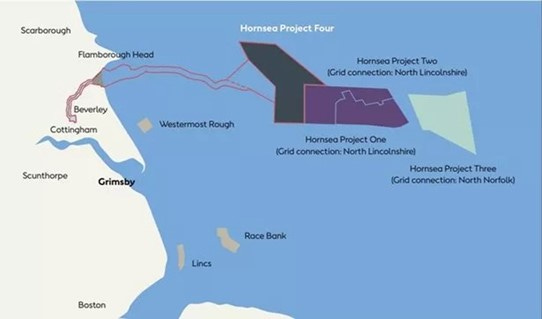Energy Musings - May 8, 2025
Orsted's decision to stop Hornsea 4 has the UK power market in turmoil. This development creates a problem for the UK. Next week we will have an article about the US offshore wind market.
Ørsted Upsets UK Net Zero Goal
UK’s Ed Miliband, Secretary of State for Energy Security and Net Zero (DESNZ), was confident that Labor’s plan for renewables to power the national grid at a lower cost was secure. However, Danish offshore wind developer Ørsted dealt him a massive body blow yesterday. The company’s CEO, Rasmus Errboe, announced it was stopping its Hornsea 4 offshore wind project, which had received a contract only a year ago in the UK’s Allocation Round 6 (AR6). The 2.4 gigawatt (GW) wind farm in the North Sea was projected to provide power for one million homes. Errboe said the value “simply wasn’t there anymore” for the project.
Hornsea 4 was an essential offshore wind capacity addition.
Ørsted said that rising supply chain costs, higher interest rates, and an increase in the project’s construction and operation risk led to a decision. These are the same risks the company has cited since 2023 as it has been forced to cancel projects and pull back from its aggressive offshore wind deployment target, while absorbing massive financial costs. The problems were so intractable that the decisions wrecked the company’s financial stability, forced the elimination of its dividend, and led to top management losing their jobs.
Errboe was appointed CEO in January with a charge to get the Danish wind farm developer back on firm financial footing. The Hornsea 4 decision will result in an estimated DKK 3.5-4.5 billion ($525-675 million) charge to financial results. Approximately DKK 0.5-1.0 billion ($75-150 million) of that total will be to eliminate capitalized construction costs currently on the company’s balance sheet. Fulfilling his charge likely was a factor in the Hornsea 4 decision.
Ørsted’s announcement followed a day after Miliband announced the results of his review of the Contracts for Difference (CfDs) for Allocation Round 7 (AR7). He has not disclosed the projected CfDs for the upcoming bidding round. CfDs are the UK government’s way to subsidize renewable energy projects. Miliband only said there would be changes to the CfD to deliver more offshore wind capacity.
Within the structure of the CfD is the “Administrative Strike Price.” Each technology has its strike price limit that bids cannot exceed in each Allocation Round. The strike price is crucial to the process, but its impact may be perverse. For example, in 2022, AR4 procured 7 GW of offshore wind capacity. The bidding competition was high, which drove the strike price down to £37.35 ($49.68) per megawatt-hour (MWh). (The strike price is based on 2012 real prices, not current ones.) The auction’s result was cheered. However, prices did not fall. A year later, Norfolk Boreas, which accounted for 20% of the procured offshore wind capacity in AR4, was shelved by developer Vattenfall, citing as much as a 40% increase in the project’s cost.
AR6, held in September 2024, had a strike price for offshore wind of £54.23 ($72.13) per MWh in 2012 prices. The bidding procured 5 GW of offshore wind. That was a noticeable improvement over AR5 when no offshore wind projects bid. However, 1.6 GW of the total procured in AR6 was permitted reductions for projects previously awarded CfDs in earlier ARs.
According to DESNZ, 31 GW of offshore wind capacity has been constructed or contracted. To meet the department’s 43-50 GW target by 2030, at least 12 GW of offshore wind capacity must be secured in AR7, AR8, and AR9. Ørsted’s decision means 2.4 GW of that 31 GW total has been removed from the pipeline, adding to the amount that must be procured in the next three ARs. If Ørsted’s observations are generally correct, the strike price offered may need to increase materially.
We do not know if Ørsted’s problems with Hornsea 4 are being experienced by other successful bidders in AR6. If the issues become more widespread, the UK will face a tougher landscape in meeting its net-zero goals. More importantly, consumers will be hit with larger power bills or higher taxes if the government uses the treasury to offset higher electricity rates.
The UK power market is unsettled as Miliband has not announced strike prices for AR7. We suspect he will be reconsidering his earlier conclusions. We also wonder about the financial challenges facing Ørsted and if they will force management to take further action. We will be watching developments on both issues.




